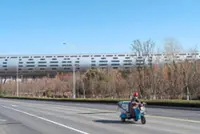Analysts said the rapid advancement of the sectors is poised to inject a renewed sense of confidence and dynamism into the world’s second-largest economy. — China Daily
BEIJING: China’s pivot toward high-tech green industries as key growth drivers is gaining momentum, with experts predicting that the “new three” – photovoltaics, lithium-ion batteries and new energy vehicles – will play a pivotal role in shaping the country’s economic landscape.
According to analysts, the rapid advancement of these sectors is poised to inject a renewed sense of confidence and dynamism into the world’s second-largest economy.





